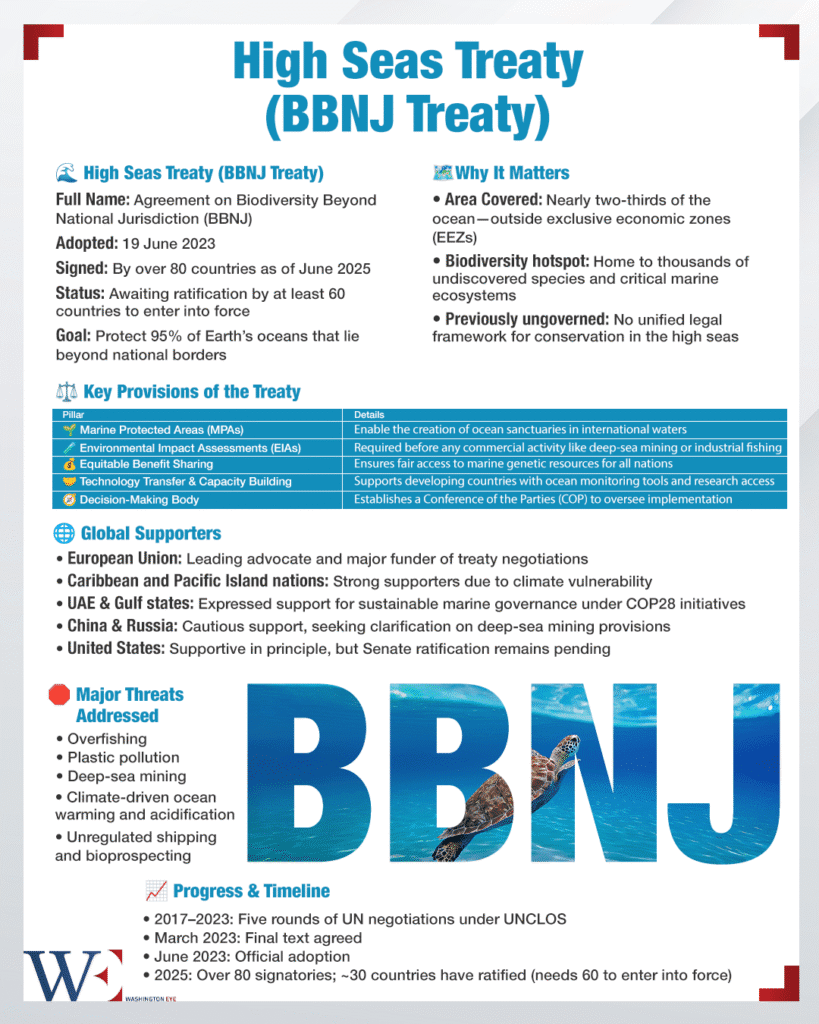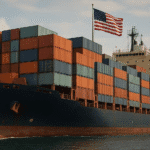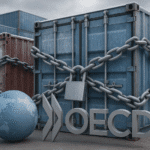by: The Washington Eye
The third UN Ocean Conference (UNOC3), held from 9–13 June 2025 in Nice, France, marked a historic milestone in the evolution of global ocean governance. It was the first major multilateral convening following the ratification of the long-anticipated Agreement on Biodiversity Beyond National Jurisdiction (BBNJ)—commonly known as the High Seas Treaty. The event brought together heads of state, diplomats, scientists, and civil society leaders to transition from treaty adoption to practical implementation for nearly half of the Earth’s surface that lies beyond national borders.
Treaty Now in Force: From Symbolism to Enforcement
The High Seas Treaty, formally adopted in 2023 and entered into force in early 2025, establishes legally binding measures for conserving and sustainably using marine biodiversity in areas beyond national jurisdiction (ABNJ). These areas, long governed by fragmented and often voluntary sectoral rules, are now subject to clearer legal obligations around environmental impact assessments, the designation of marine protected areas, and equitable benefit-sharing of marine genetic resources.
At UNOC3, parties to the treaty agreed to initiate the first round of scientific advisory panels, and several countries—including members of the European Union and small island developing states—committed funding for capacity-building in the Global South. However, the implementation timeline remains ambitious, with major governance instruments still to be operationalised by 2027.
Ecological Law and Planetary Stewardship
The legal architecture of the BBNJ Treaty was repeatedly described at UNOC3 as a move toward “ecological law”, a framework that reorients legal obligations around the intrinsic value of nature rather than purely anthropocentric economic goals. Legal scholars such as Sarah Reiter and Dillon Post underscored that the treaty signals a decisive shift away from doctrines that historically placed state sovereignty above ecological integrity.
This shift is timely. With over 60% of marine life estimated to reside in ABNJ ecosystems, threats such as deep-sea mining, overfishing, and plastic pollution continue to exert global pressure. Several plenary sessions at the conference warned that without robust enforcement mechanisms, the high seas risk becoming a lawless frontier for resource extraction.
The U.S. Role: Leading Without Signing?
The United States attended UNOC3 with a high-level delegation, yet its status remains complicated. Despite its influential role in shaping the BBNJ negotiations, the U.S. has still not ratified the United Nations Convention on the Law of the Sea (UNCLOS)—the foundational treaty framework underpinning the High Seas Treaty.
Nevertheless, the Biden administration reiterated its support for the treaty’s core objectives. The White House cited its Ocean Climate Action Plan and recent investments in blue carbon initiatives under the Inflation Reduction Act as evidence of domestic alignment with BBNJ principles. Several analysts pointed to the U.S.’s strategic use of scientific diplomacy and climate finance as a form of soft power, positioning it as a de facto leader—even without formal ratification.
Global South Demands Equity and Accountability
One of the most heated topics at UNOC3 was the equitable sharing of benefits arising from marine genetic resources, especially those used in biotechnology and pharmaceuticals. Delegates from African, Latin American, and Pacific nations urged for clearer mechanisms to ensure transparency and fairness, warning that unequal access to data and technology could perpetuate neo-colonial dynamics.
A proposal to establish an international benefit-sharing clearinghouse gained broad support, although final design and governance are still under discussion. Countries also emphasised the need for open-source databases, shared scientific infrastructure, and funding for indigenous-led marine stewardship.
Institutional Overlap and Fragmented Authority
Despite high ambitions, several panels cautioned about institutional fragmentation. Bodies like the International Maritime Organization (IMO), FAO, and ISA (International Seabed Authority) already operate in overlapping domains. Questions remain about how the BBNJ Treaty’s institutions will coordinate with these legacy entities without duplication or conflict.
To address this, UNOC3 closed with an agreement to form an inter-agency task force under the UN system to streamline reporting requirements, data exchange, and compliance verification. A first follow-up technical workshop is scheduled for early 2026 in Nairobi.
Strategic Outlook: Ocean Governance at a Turning Point
The third UN Ocean Conference ended with both cautious optimism and clear warnings. Delegates agreed that this was not merely a symbolic gathering, but a decisive inflection point for the future of international ocean governance. As implementation begins, the true test will be political will—particularly from non-signatory powers like the United States and China.
The U.S. faces a pivotal choice: continue exerting influence from the margins, or formally join the legal frameworks it helped shape. As the world’s largest funder of marine science and a dominant naval and commercial actor, its engagement—whether formal or informal—will shape the trajectory of the treaty’s success.
The Lisbon Conference of 2022 laid the groundwork. The Nice Conference of 2025 set the treaty into motion. What comes next will determine whether the international community can truly safeguard the high seas in the Anthropocene era—or whether this governance experiment will remain adrift in aspirational rhetoric.















